Toulouse and the Machines – A Guide to A Fascinating City with a Steampunk Twist
Tucked away in the southwestern corner of France, you’ll find Toulouse. It’s the fourth largest city in France and a gateway to the Pyrenees and the Principality of Andorra. Join me, and explore some of the highlights of the city, including its marvellous steampunk machines, it’s rich history and mouth-watering gastronomy.
If you’re ready to dip into the delights of this city, this guide is for you. It covers everything from must-see sights and essential day trips, including Carcassonne, to transport tips and practical details.
Planning a Trip To Toulouse? Here’s Where You’ll Find Things
Most recently visited in May 2024 all information reviewed and updated in June 2025
More travel inspiration from One Small Bag
This guide may include a few affiliate links. If you choose to buy something through one of them, I may earn a small commission (at no cost to you). Thank you for supporting One Small Bag and helping keep this resource ad-free and independent.
Is Toulouse Worth Visiting?
Perfect for … 🌆 A vibrant French city break • 🧱 Terracotta architecture & pink-hued sunsets • 🤖 Steampunk machines & creative flair • 🍷 Food, wine & market lovers • 🏰 Easy day trips to Carcassonne & beyond
Toulouse is known as La Ville Rose (the Pink City), thanks to the terracotta bricks that glow warmly at sunset. It’s a lively city, with a lot of students, a world renowned aerospace and technology industry and it’s rugby mad! A beautiful French city, so what’s not to like? But the thing which really set it apart, for me, were the Toulouse machines. Do visit the Halle de la Machine. It has to be the only place where you can ride a 14-metre mechanical minotaur or eat lunch served by robotic contraptions straight out of a Jules Verne Novel. This place is fun, however old you are! Built by the same team behind Nantes’ steampunk elephant, these fantastical creations were the highlight of my trip.
Of course, Toulouse has the grand squares, Gothic churches, and riverside walks you’d expect from a French city – plus excellent markets and easy train connections for day trips. For many reasons, it’s exceptional, but if you only remember one thing from Toulouse, make it the machines.
Where to Stay in Toulouse
The central St Etienne areas and around the Capitole will ensure you are placed right at the centre of the action. I found Toulouse more reasonable to stay in than some other parts of France, so you may be able to stay central without breaking the budget, especially out of season. I wanted something in easy distance from the bus and train station and wanted a budget option as some of the hotels in the very centre, were more than I wanted to pay, especially as I was travelling solo. The Ibis Styles Canal Midi proved to be a good bet. Here are some more options for your stay in Toulouse.
Map of Things to Do in Toulouse
Visiting Halle De La Machine
Halle de La Machine is part museum, part theatre, and part playground for giant mechanical creatures and for me, the highlight of my visit to Toulouse.
Arrival at La Halle de La Machine
Astérion is a colossal 14-metre-tall minotaur weighing 47 tons. You can actually climb aboard as it strides slowly through the Montaudran district – it feels surreal, like riding a moving piece of artwork. And Astérion isn’t alone. His “friend” Ariane the Spider lurks nearby, stretching 13 metres high and 20 metres long. They make quite a statement, together outside the Halle as you go in,

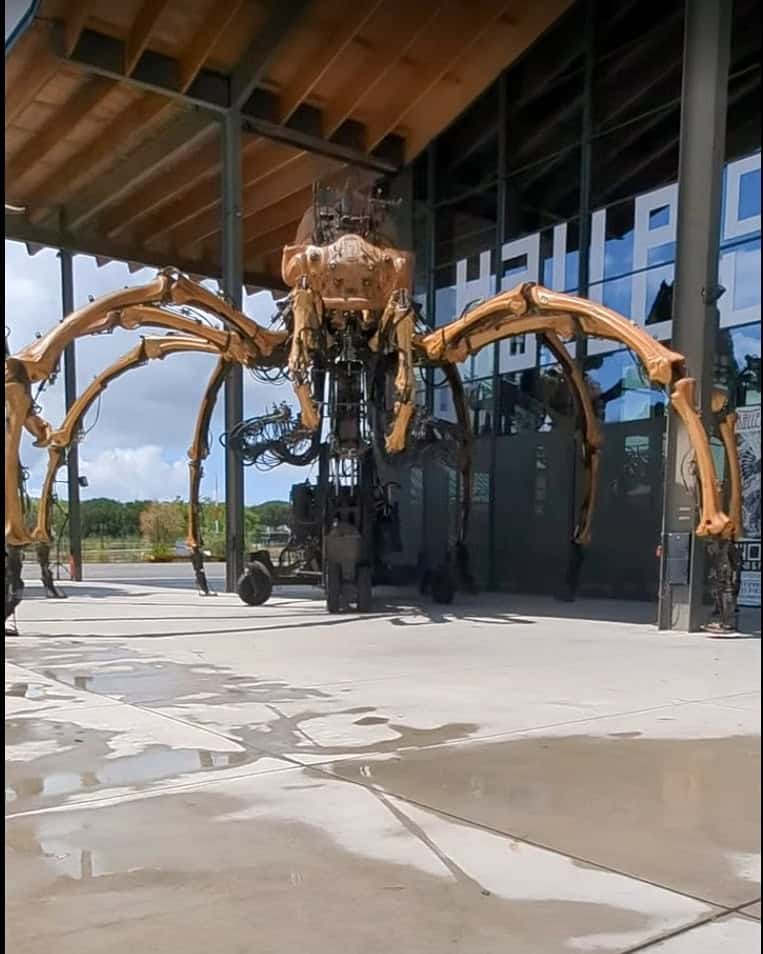
From Concept to Creation
The magic of these machines is that they’re not just engineered, they’re imagined into being. The process begins with research into how animals move, followed by Leonardo da Vinci-style sketches and intricate scale models. Only then do the full-sized builds take shape in workshops buzzing with welders, carpenters and machinists in orange overalls.
The inventor and artistic director behind all this is François Delarozière, who founded the company La Machine in 1999. La Halle is run by the same artistic company, La Machine, who also created Nantes’ famous mechanical elephant. If you’ve visited there, Toulouse feels like its sister city in steampunk form.

The creations in both Nantes and Toulouse are heavily inspired by Jules Verne’s fantastical worlds, where science and imagination collide. Each new creature is “born” in public, through live shows designed to surprise and move the audience.
Inside the Halle
Step through the glass walls and you’ll find a menagerie of smaller but equally imaginative creations: dragons, insects, and contraptions that pour drinks or even serve food. On some days you can book the “Lunch of the Little Mechanics”, where mechanical waiters deliver your meal (though not the Minotaur – he’s far too big).
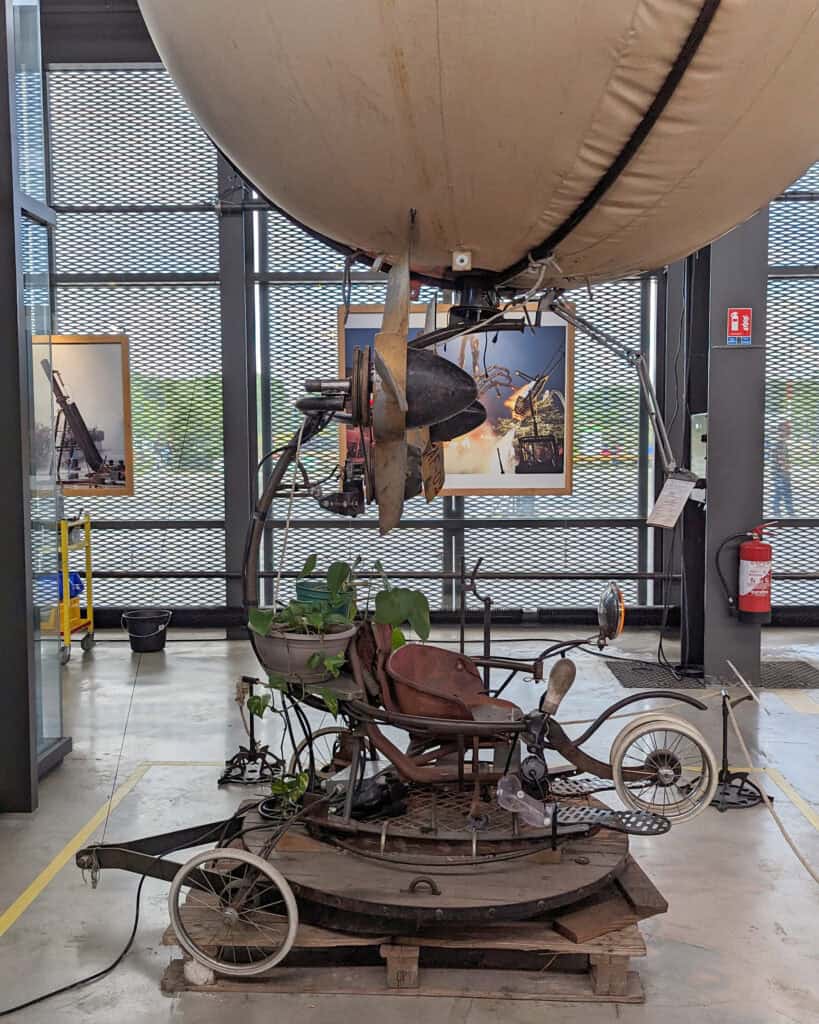

Backdrop – Da Vinci style Drawing
What You Can Do
- Explore the main hall – wander among the machines, watch demonstrations, and sometimes even take part.
- Ride the Minotaur (Astérion) – a 25-minute ride on a walking giant (book in advance).
- See Ariane the Spider – Astérion’s 20-metre-long companion, often photographed together.
- Hop on the Carré Sénart carousel – a quirky, smaller mechanical ride.
- Book the Lunch of the Little Mechanics – a sit-down meal served by machines (seasonal/limited).
- Pair with aviation history – next door, on the Piste des Géants, you’ll find the Aeroscopia aviation museum and early-flight exhibits.
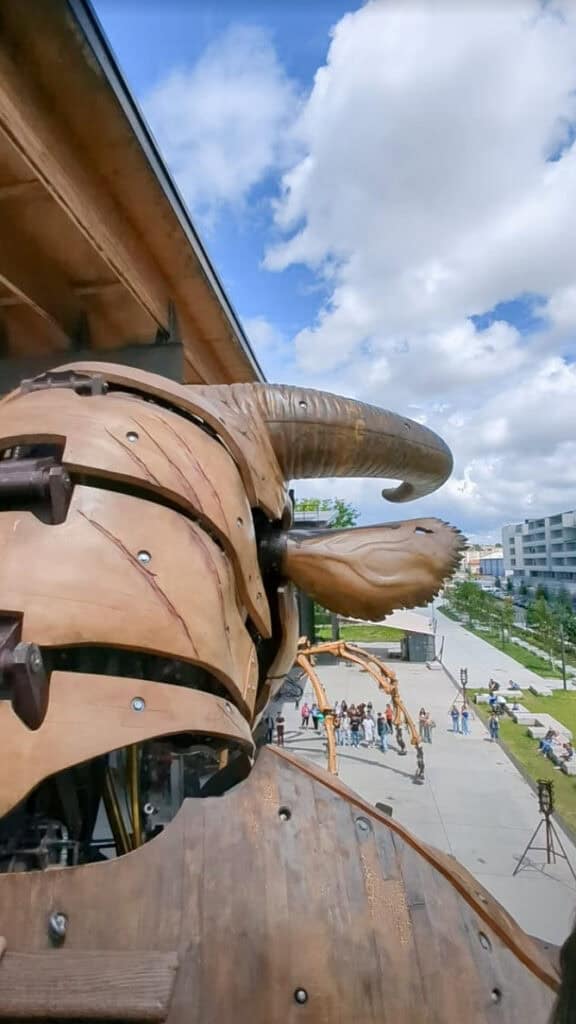
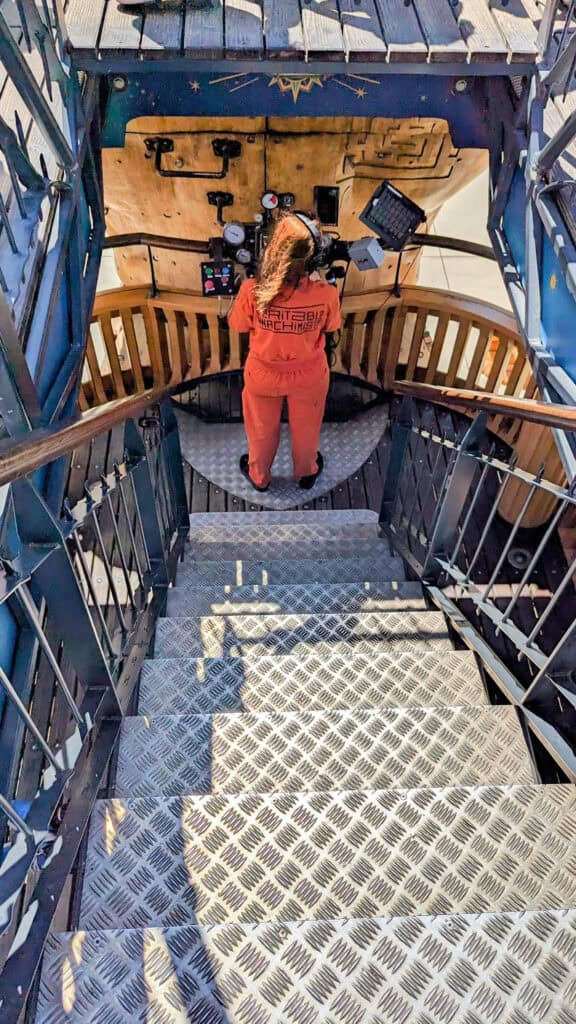
Practicalities
- Getting there: I took a 10–15 minute bus ride from Guilhemery to Latécoère, then walked a few minutes to the Halle.
- Opening hours: Tuesday–Sunday (closed Mondays). Hours vary by season; Minotaur rides run at set times.
- Tickets (guide prices):
- Halle visit €12 (about 1h30)
- Minotaur ride €12 (25 mins)
- Combo ticket €21
- Carousel €3.50
- Lunch of the Little Mechanics €65
- Reduced and super-reduced fares available; under-5s often free
- Booking tips: Reserve Minotaur rides and Lunch ahead of time, especially weekends/holidays. Hall entry is usually fine same-day.
Other Things To Do in Toulouse
So now, we’ve mentioned the Toulouse Machines, here’s everything else from this magnificent city.
Capitole de Toulouse

The Place du Capitole is a huge grand square flanked by cafés. The Capitole building, with it’s pink and gold neoclassical facade, is both imposing and theatrical. It houses both the town hall and the Théâtre du Capitole.


If it’s open, do head inside to see the famous Salle des Illustre which has been in use since 1898. It’s free to enter and is one of Toulouse’s grandest rooms. Unfortunately for me, there was an event on, but the brief peek I did get inside, gave a hint of the over-the-top grandeur. Once inside the Salle des Illustres, you will find plenty of chandeliers, columns and statues of Toulouse’s illustrious men (just men!). While a number of the ‘marble’ statues and columns are apparently fake (made from clay), they still look convincingly fancy from the photos!
If you leave the Place du Capitole, via Rue du Taur, you will pass through a picturesque street full of grand architecture and cafes. This will lead you to the basilica and Couvent des Jacobins.
Couvent des Jacobins
A short stroll from the basilica leads you to the Couvent des Jacobins, a masterpiece of Southern French Gothic architecture. Founded in the 13th century by the Dominican Order, the convent is renowned for its unique ‘palm tree’ column. It’s a pillar that fans out into 22 ribs supporting the vaulted ceiling. It’s stunning!
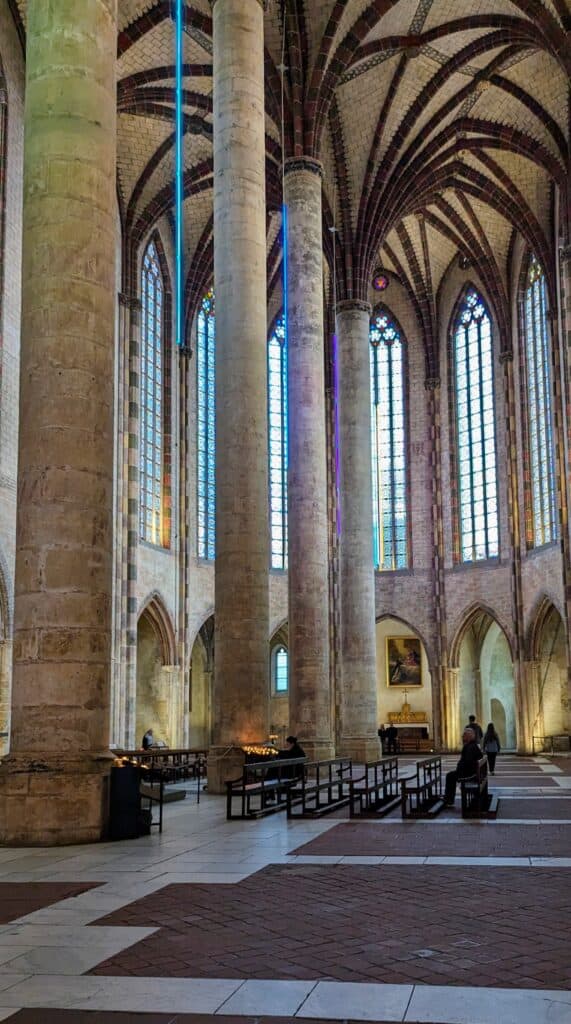
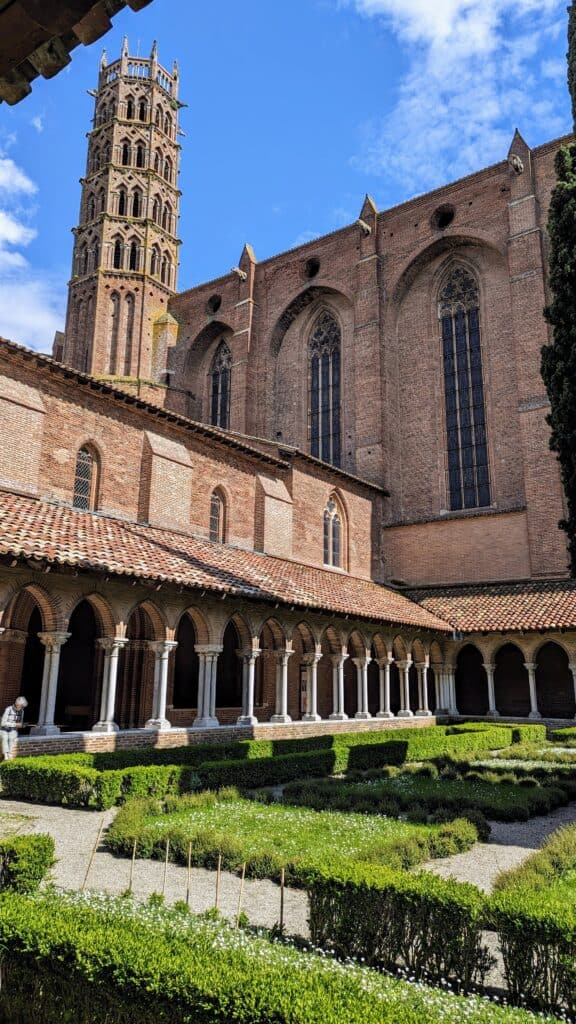
The serene cloister and the chapel of Saint Antonin, adorned with 14th-century frescoes, offer a glimpse into the monastic life of the past. Entrance to the church itself is free, but you will need to pay an admission fee of €5 to access the cloister, the convent areas and museums, which I recommend you do.
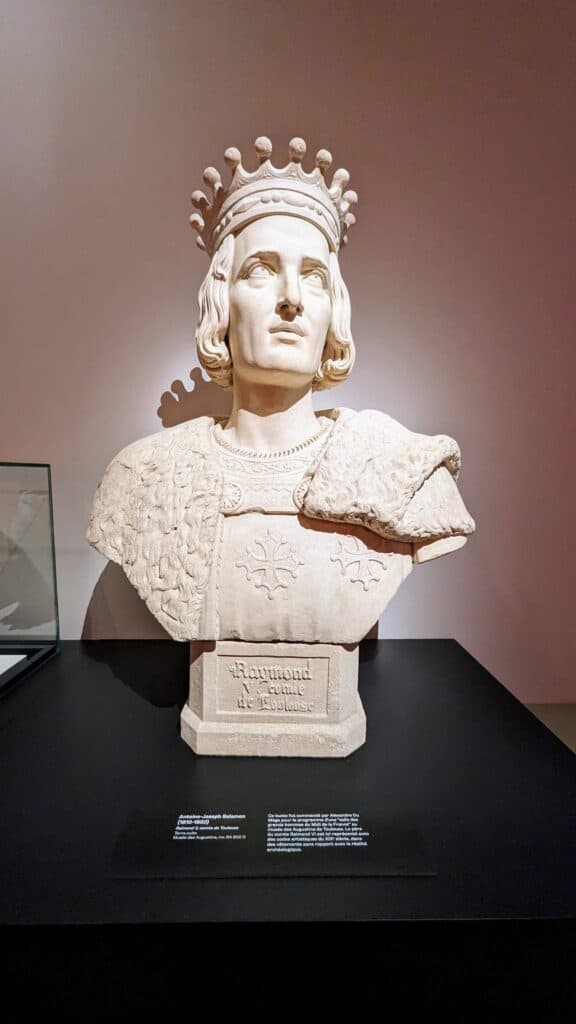
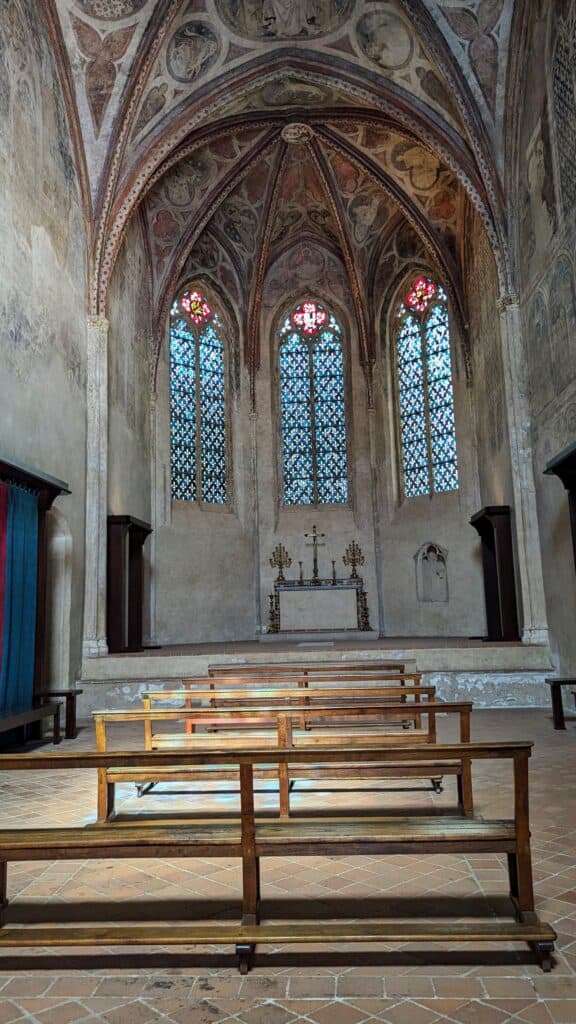
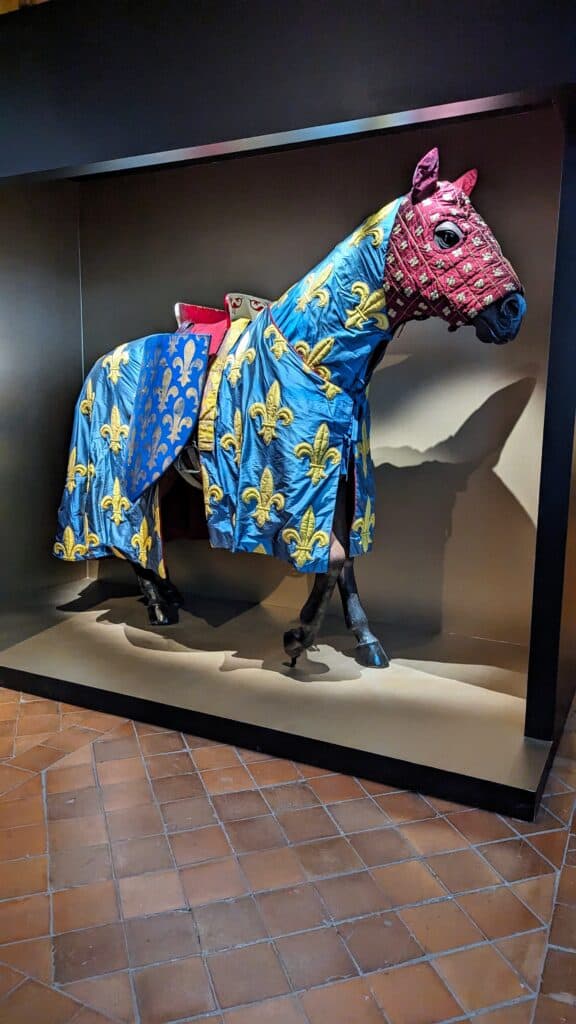
Basilique Saint-Sernin
The Basilique Saint-Sernin stands proudly in the heart of Toulouse. It’s one of the largest remaining Romanesque buildings in Europe. Its grandeur is evident in the intricate sculptures and the towering octagonal bell tower that reaches 67 meters into the sky. The basilica houses the relics of Saint Saturnin, the first bishop of Toulouse, making it a pivotal stop on the pilgrimage route to Santiago de Compostela. While entry to the main church is free, accessing the crypt and the ambulatory, requires a modest fee of €2.50 which I was happy to pay. .
Cathédrale Saint-Étienne

In any other city, this Cathedral would be a top draw, but with the world class Basilique Saint-Sernin and Couvent des Jacobins, demanding your attention, this one is easily overlooked. It’s.a working cathedral and while it has the impression of being several buildings knocked together, it’s set beautifully in amongst the streets of the old city and well worth a peek inside too,
More travel inspiration from One Small Bag
Place Dupuy and Halle aux Grains
Just east of the city centre, Place Dupuy is a graceful, triangular square that quietly celebrates one of Toulouse’s local heroes, General Dominique Martin Dupuy. There’s a tall, elegant column with a golden statue of Dame Tholose on top. She’s an allegorical figure representing the city itself. There’s also a striking fountain.


The Place Dupuy is also home to Halle aux Grains, the striking hexagonal building at one end of the square. Originally built in the 1860s as a grain market (hence the name), it’s now a respected concert venue and home to the Orchestre National du Capitole.
I passed by just as people were going in for an evening performance and immediately regretted not checking the programme in advance. If you’re planning a trip, it’s well worth seeing what’s on! Booking ahead is usually a good idea, especially for major performances.
Donjon du Capitole
In the heart of the city, tucked behind the grand façade of the Place du Capitole, stands the Donjon du Capitole — a striking 16th-century tower that looks like it’s been plucked from a medieval fairytale. Once used to store the city’s archives and treasures, it’s now home to something a little more practical: the Tourist Information Office!
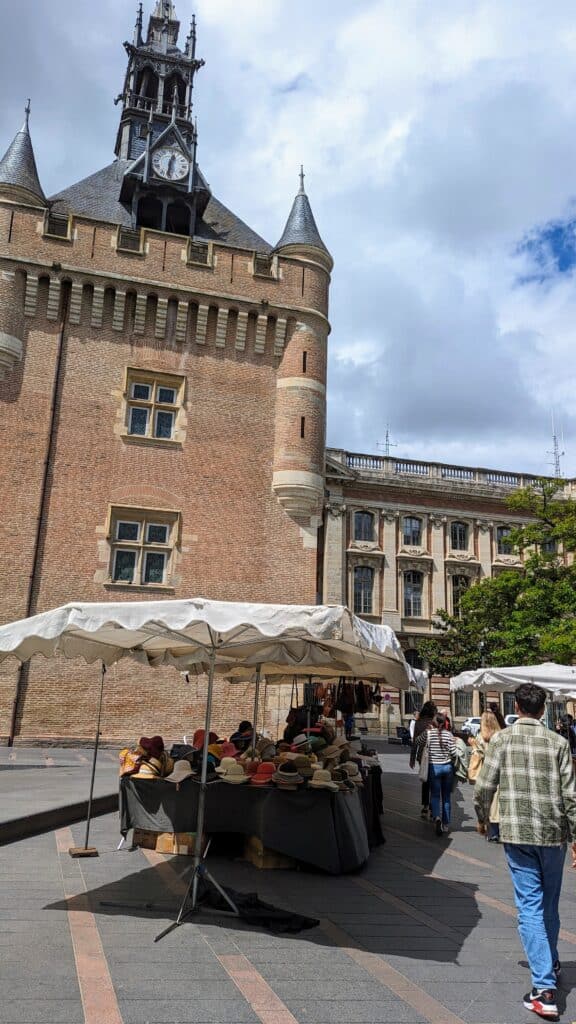

When I suggested going inside it wasn’t some throw away comment, suggesting you pick up a map and a few leaflets. Really do go inside! It’s grand with vaulted ceilings and an ornate staircase. You’d be hard pushed to find many other tourist information offices which are quite so glamorous!
Canal du Midi
The Canal du Midi cuts a slow, steady line through Toulouse. It was designed in the 17th century to connect the Atlantic to the Mediterranean. You’ll see locals cycling or walking their dogs, students sitting on the banks, and the occasional boat slipping past.
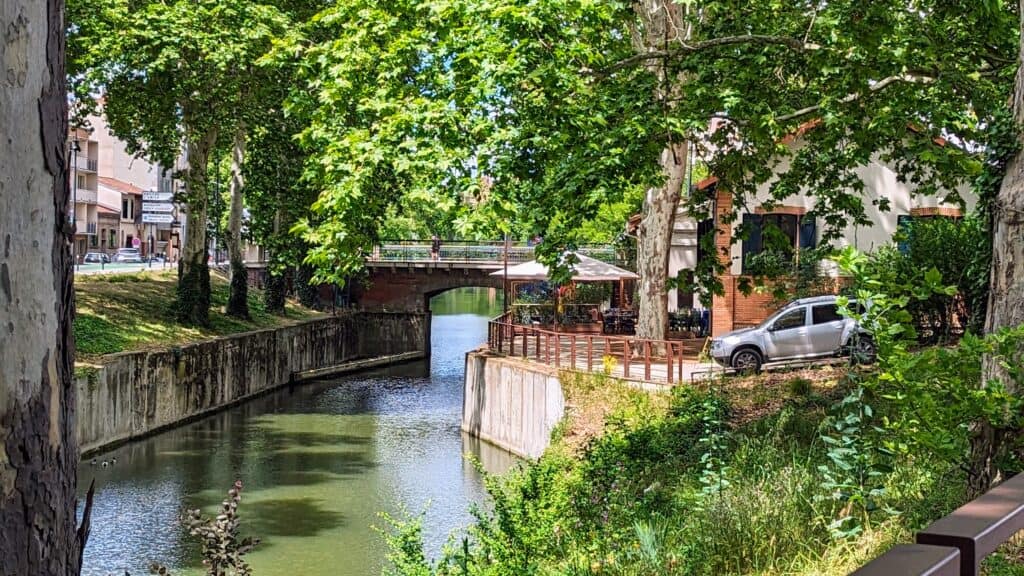
If you are in Toulouse in the summer it’s an excellent place to find some shade along the tree-lined and quietly elegant green corridor running through the city.
Sunset over the Garonne
If you are like me, you carry a picture with you in your head of a places, before you visit. For me this is the ‘Toulouse’ I was expecting! The banks of the Garonne are the place to come in the early evening and enjoy the rosy glow over the river and the striking Pont Neuf, which is the oldest bridge in the city, despite its name!
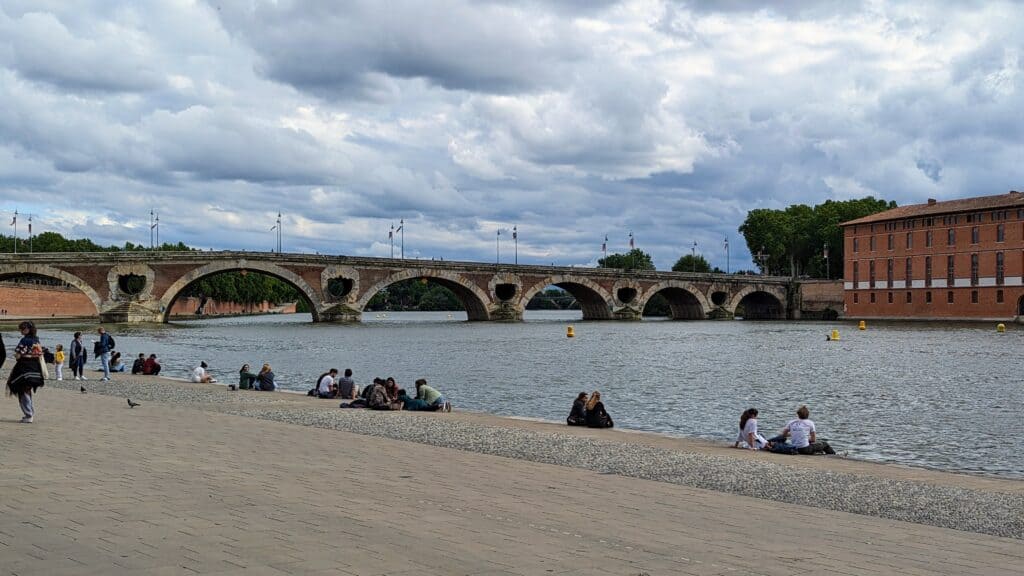
The views are glorious on both sides, but especially westward towards the dome of La Grave and the Saint Cyprien Quarter. Locals gather along the quayside, drinking, chatting, or just sitting quietly. The University is close by, so the spot is popular with students too.
City Art Scene
Situated in the Saint-Cyprien district, Les Abattoirs is a contemporary art museum housed in a former municipal slaughterhouse dating back to 1823. The museum’s collection includes approximately 3,880 modern art works, ranging from the 1950s to the present day. It’s worth noting Les Abattoirs is open from Wednesday to Sunday, Hopefully you can time your visit better than me! Other places to enjoy in Toulouse include:
- Le Château d’Eau – a photography gallery in a former water tower. Surprisingly cool if you’re into photo exhibitions.
- Jardin des Plantes + Museum of Natural History
- Raymond VI Garden, offering a pleasant space to relax and enjoy views of the Garonne River
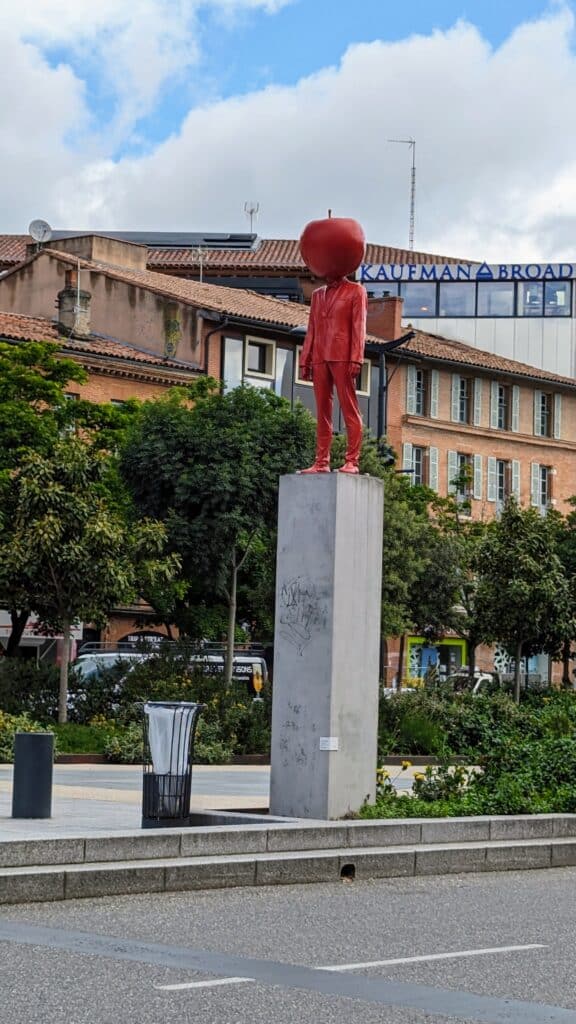

Toulouse has plenty of street art too, both murals and statues. Here we have the red apple man who is on the All. Jean Jaures (the street leading from the train station into the city centre) plus some street art on the way to do Halles de La Machines.
Markets & Shopping
Toulouse is France’s fourth city, so you can expect an extensive shopping district which you may well pass through on the way to the Capitole. Rue d’Alsace Lorraine is the main street. You will be treated to grand buildings and cafe lined streets in amongst the specialist boutiques and larger brand stores.

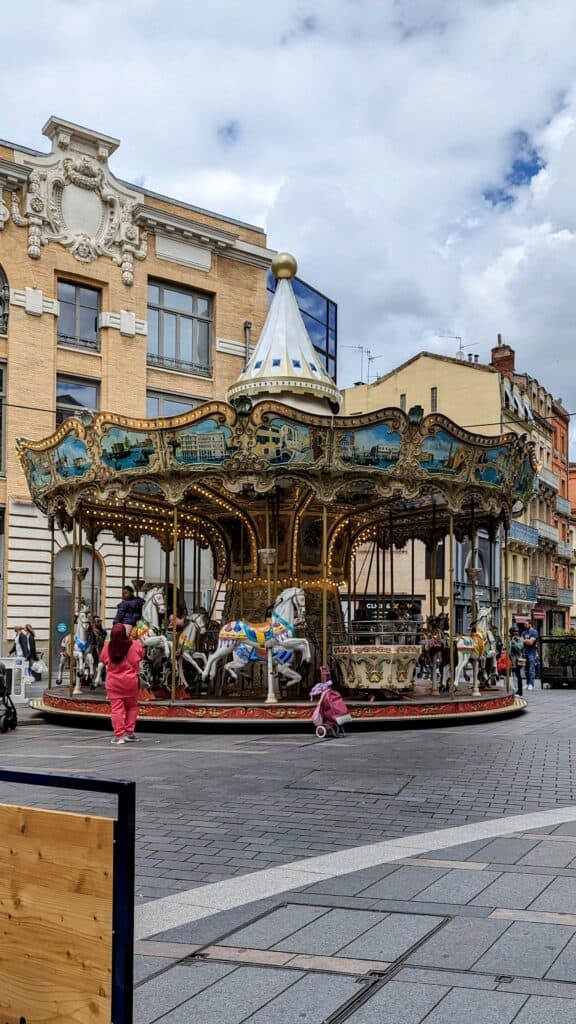
If you’re after a taste of the city or something genuinely regional to take home, head to one of the main covered markets: Victor Hugo is the biggest and best known, open mornings from Tuesday to Sunday. It’s packed with high-quality deli goods — cheese, charcuterie, wine, bread — and upstairs, you can eat dishes made from what’s being sold downstairs. Marché des Carmes is smaller but more charming. Both are good places to pick up edible souvenirs.
If you’re on the hunt for regionally made gifts, keep an eye out for:
- Pastel-dyed textiles (Toulouse’s historic plant-based blue dye) – scarves and fabric items at local craft stalls
- Violet products – sweets, liqueur, soap, and even mustard made from the city’s iconic flower
- Cheese and charcuterie – particularly from Victor Hugo’s market stalls
- Wine and spirits – Fronton reds, Armagnac, and small-batch liquors make easy gifts
So far the things to do in Toulouse I’ve mentioned have all been in the city centre. The next three are further out, but all still accessible by public transport.
Cité de l’Espace & Aeroscopia
On the eastern edge of Toulouse, the Cité de l’Espace brings the cosmos a little closer to Earth. You can wander through a life-size model of the Mir space station, admire the towering Ariane 5 rocket, or squeeze into a Soyuz capsule and pretend you’re on your way to the International Space Station. There’s a mock control room where you can simulate launching a rocket and placing a satellite into orbit. The Astralia building houses a huge 280-seat planetarium with a 600m² dome, plus an IMAX theatre showing space-themed films if your feet need a break.
Feeling brave? Strap in for the LuneXplorer, a centrifuge that simulates a rocket launch and lunar landing – complete with video guidance from actual European Space Agency astronauts. Just try not to scream. I was very disappointed to miss this activity as it’s not open every day. It’s open Wednesday to Sunday, 10:00–18:00 (late opening until 20:00 on Thursdays). Tickets are €24.50 for adults, €18.00 for kids aged 5–18. So do ensure you do better than me if you want to visit!
Just a short tram ride from the city centre, the Aeroscopia Museum in Blagnac is another dream come true for aviation enthusiasts and curious minds alike. This expansive museum showcases over 40 aircraft, including legends like the Concorde, the Airbus A300B, and the Super Guppy. Visitors can explore the interiors of these iconic planes, getting up close with the engineering marvels that have shaped aviation history.
You’ll also find interactive exhibits, flight simulators and themed tours.It’s open daily from 9:30 AM to 6:00 PM (last entry at 5:00 PM) and longer during school holidays. Adult admission €15, Reduced Rate: €12 and under 6’s free.
Gastronomic Delights of Toulouse
Toulouse is well known for its food. There’s of course excellent bread and pastries as there are everywhere in France. For me breakfast had to be in St Georges Square with the best croissants in the city at La Boulange Saint-Georges. Delicious.
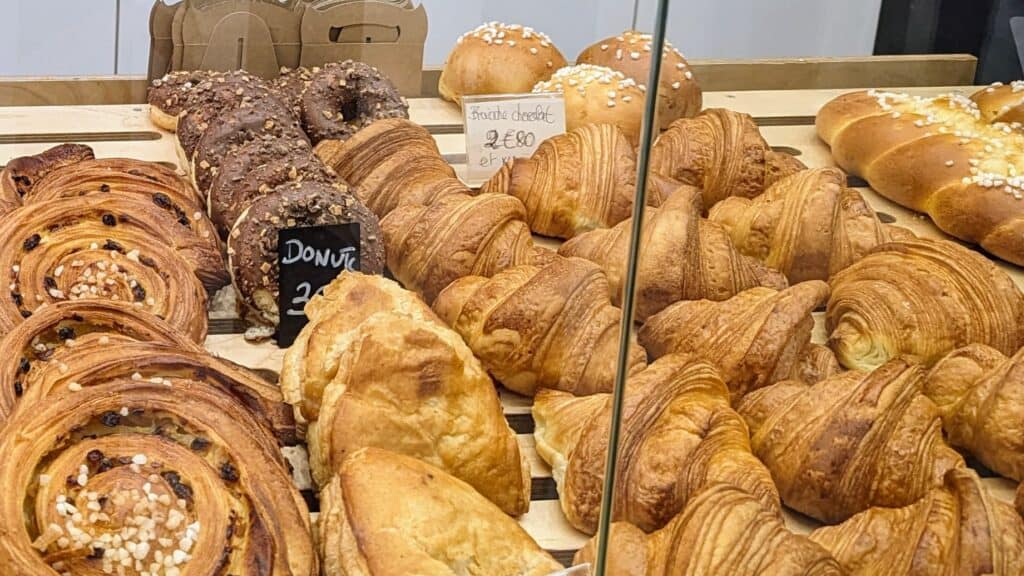
The Toulouse Sausage is definitely something you will see served in Toulouse restaurants. Either served as Saucisse de Toulouse, or in other dishes, such as these two, popular in Toulouse.
Duck also appears in a number of recipes from the South West of France. Pate made from Duck and Goose are popular. Here’s my Parmentier de Canard, which I think is best described as a rich version of Shepherds Pie, but made with duck meat. Plus the popular French dessert, Creme Brulee.

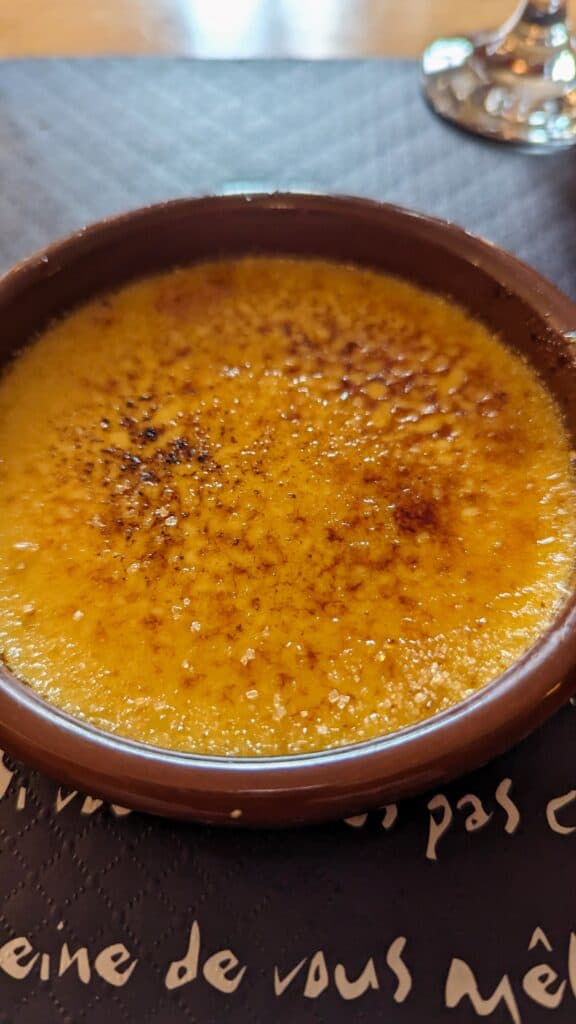
These are other desserts and sweet treets to look out for which are specialities in Toulouse.
Toulouse is very much a cosmopolitan city, so if you want to depart from the traditional French fare, and especially if you are on a budget, you will find plenty of other restaurants too. I picked an Italian restaurant, Don Vincenzo, on St Georges Square. The pasta all’arrabbiata was excellent and very authentic. At €15 it was a cheaper option than the more upmarket French restaurants on the square.
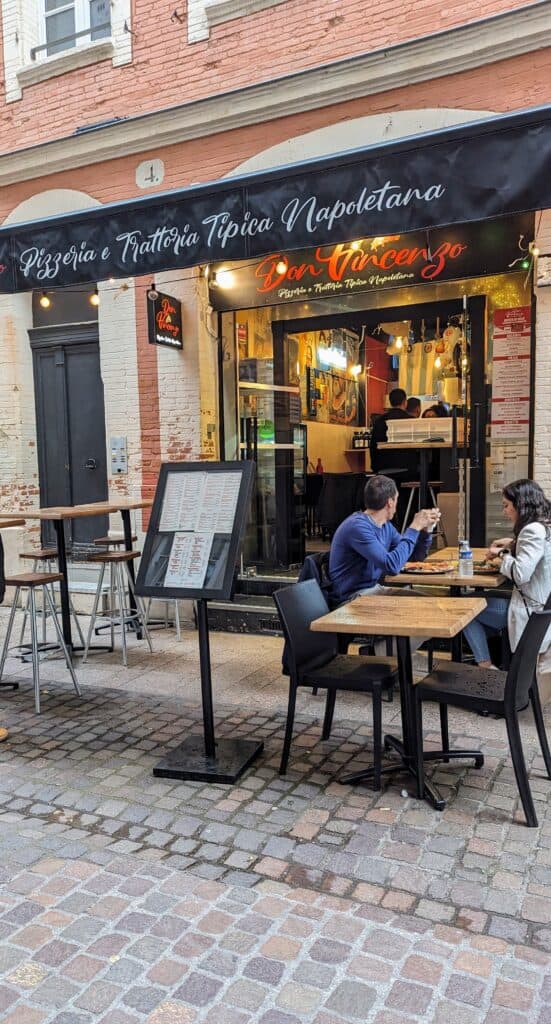
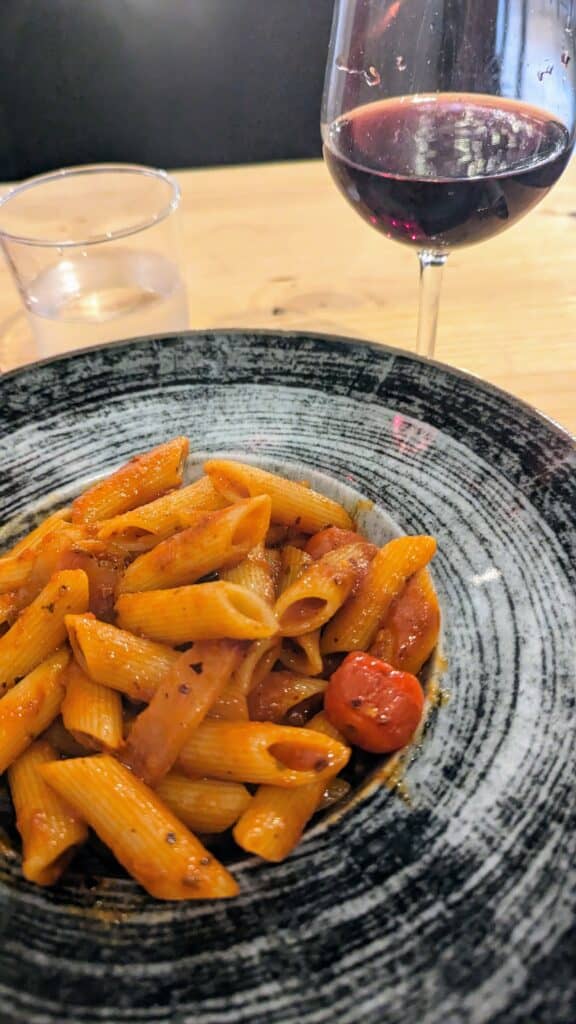
Tours and Activities in Toulouse
There’s a wealth of different activities and guided tours in Toulouse and they are an excellent way to understand the city better. Here are a few top rated trips.
How to Get to Toulouse
Toulouse-Blagnac airport has a range of international flights, mainly to and from other European cities. There are several public transport options into the centre from the airport
It’s around 5 hours on the train from Paris. There is also a sleeper service taking around 9 hours. Both services arrive at Toulouse Matabiau Central Train Station. The regional trains use the same train station,
I arrived by Flixbus from Paris which took around 9 hours arriving in Terminal de Bus de Toulouse which is just beyond Toulouse Matabiau Central Train Station (about 5 minutes walk).
My onward travel to Andorra using Andbus arrived and left from the Terminal de Bus de Toulouse .
Take a Day Trip from Toulouse
Once you’ve explored things to do in Toulouse, why not take a day trip? There’s an array of excellent options for day trips from Toulouse as the city is particularly well connected by train.
To save on train tickets, book early and avoid peak hours. Check for TER deals and IiO deals, especially to Montauban or Carcassonne.
Map of Day Trips
Top Day Trips
Carcassonne is just an hour away and is one of the most famous medieval cities in France, and rightly so — it’s like stepping into a fairy tale. The Cité de Carcassonne is a UNESCO World Heritage Site with double walls, towers, and a drawbridge. It’s free to walk around the citadel, but worth paying to go inside the castle and ramparts. Outside the walled city, don’t miss the Pont Vieux and the more “local” side of Carcassonne in the Bastide Saint-Louis across the river.
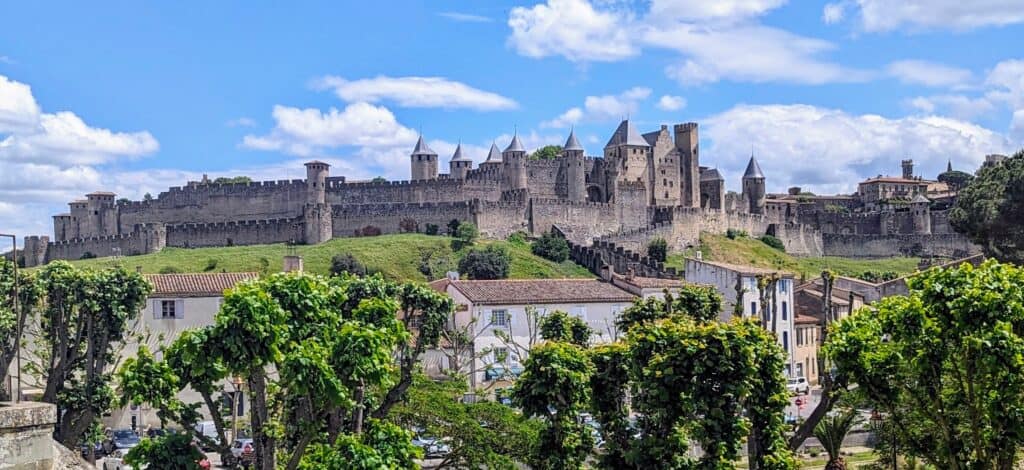
Best visited early or late in the day to avoid the heaviest crowds — or in shoulder season. It’s great for photographers, history buffs, and lovers of a good cobbled street.
Here are some other possible day trips:
Albi (1h by train)
Compact riverside city and birthplace of artist Henri de Toulouse-Lautrec — you’ll find a major museum dedicated to him inside the old bishop’s palace. The Cathédrale Sainte-Cécile is jaw-dropping: the largest brick-built cathedral in the world, with a richly painted ceiling and fortress-like exterior. The Episcopal City is a UNESCO site, and the view from the riverbanks or the Pont Vieux is stunning. Albi is walkable and elegant, with a laid-back charm — an excellent low-stress day trip. Group Tours are also available from Toulouse
Castres (1h15)
Peaceful riverside town with colourful houses over the Agout River. Visit the Goya Museum (Spanish art, including Goya) and Musée Jean-Jaurès (local hero and politician). A relaxed and ‘under-the-radar’ alternative to some of the other more touristy alternatives.
Gaillac (1h)
One of France’s oldest wine regions. Explore the beautiful town centre and visit the Maison des Vins de Gaillac for tastings (no car required). For vineyard visits, you’d need a car (e.g. Château Lastours). Group Tours are also available from Toulouse
Auch (1h30)
Capital of Gers and former heart of Gascony. Climb the Grand Escaliers to see the statue of D’Artagnan. Visit Sainte-Marie Cathedral and explore the historic centre. There’s a bustling market on Thursdays and Saturdays.
Cahors (1h10)
Known for deep red wines, truffles, and foie gras. Don’t miss the Pont Valentré (UNESCO-listed) and secret gardens trail. Market days are Wednesdays and Saturdays. Local wineries nearby (best accessed by taxi).
Bordeaux (2h15)
A lively, elegant city and global wine capital. Highlights: Miroir d’Eau, Marché des Capucins, cannelés pastries, and top-tier museums. Probably a bit ambitious for a day trip, but possible. Or why not pack an overnight bag and stay over?
Moissac (50 mins) & Montauban (30 mins)
Both are on the same train line, so you can do both in a day if you’re efficient! Head to Moissac for its 12th-century abbey and cloisters. It’s also a key stop on the Camino de Santiago. Montauban is France’s oldest bastide (fortified) town, great cafés and arcaded squares.
Najac (1h20)
Picture-perfect medieval village with one of France’s “Most Beautiful Villages” labels. Visit Château Royal de Najac with its record-breaking 7m-high dungeon and scenic views over the Aveyron Valley.
Castelnaudary (45 mins)
This is the birthplace of cassoulet, the hearty southwest French stew. It’s a scenic town on the Canal du Midi. Relax at the harbour and enjoy a traditional lunch on Place de Verdun.
If you would prefer an organised tour, rather than travelling independently, there’ plenty of options too.
Toulouse has all the ingredients of a classic French city break, but for me, it was the machines that made it unforgettable. Along with Nantes, it’s one of Europe’s true steampunk capitals, where art and engineering combine on a massive scale. If you’re building a European bucket list, don’t just stop at Paris, France. Make room for the Pink City and its mechanical beasts and take advantage of its excellent location for numerous quality side trips including Carcassonne and Andorra.
Have you visited Toulouse? Are you planning a trip? Let me know in the comments.
Thanks for Reading. If you are still curious, here’s some top posts from the One Small Bag blog.
-
Best Things to Do in Skopje: Your Comprehensive Travel Guide to Europe’s Most Kitsch Capital
Skopje mixes kitsch statues, Ottoman charm and Balkan buzz. This guide on things to do in Skopje covers the city highlights both in the Ancient City and beyond including the modern facades and statues created as part of Skopje Project 2014
-
Visiting Old Orhei (Orheiul Vechi): Moldova’s Cave Monastery & Dramatic Landscapes
A cave monastery, ancient ruins, and dramatic valley views — Old Orhei is Moldova’s most spectacular day trip from Chișinău.
-
Minimalist Travel Essentials: My Top 15 Tiny Travel Accessories
Packing light may sound straightforward, but it took a lot of practice and mistakes to refine and get to the…